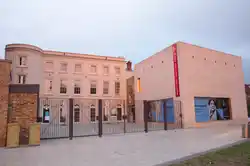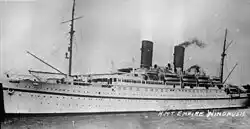
The Black Cultural Archives, Brixton (BCA) is an archive and cultural center dedicated to the history of black people in London, England and Britain as a whole. It is based out of Brixton in south London, a district of the English capital which became a major center of black and Caribbean habitation in the post-Second World War era. The BCA was established with the goal of retrieving and properly acknowledging the role that black people, primarily of Caribbean and African background, have played in British life over the centuries, particularly so since the late 1940s when the Windrush Generation began to transform the demography of London. The BCA is an excellent resource for anyone tracing their family history or an ancestor who comes from a black community within London or some other location in Britain.[1]
Research your ancestors on MyHeritage
History of the black community in BritainHistory of the black community in Britain

The history of the black community in Britain is largely a modern story, though there is little doubt that some black people have been in England and other parts of the island since ancient times. For instance, the Romans had a presence in England and Wales for over three and a half centuries, between the first invasion of the island in 43 CE and the strategic withdrawal from it in 410 CE. Some black slaves that were traded into the empire through North Africa must have ended up in Britain from time to time, though any extensive records of their passage are now lost. There is a record of a black person in England in the Domesday Book produced in the late eleventh century under the orders of William the Conqueror. By the time of King Henry VII, at the start of the sixteenth century, there was a black trumpeter at the royal court. Thereafter the commencement of the Transatlantic slave trade increased the number of black people in England.[2]
By the advent of the Industrial Age in the second half of the eighteenth century, there were perhaps as many as 20,000 black people in Britain. Approximately three-quarters of these were in London. It was also around this time that the Abolition movement started to emerge as a major political lobby in England and over the space of the next six or seven centuries figures like William Wilberforce brought the slave trade into focus, eventually leading the British to ban the slave trade in 1807 and the institution of slavery altogether in 1833. Over the remainder of the nineteenth century and into the twentieth a steady trickle of black people from all over Britain’s vast empire continued to either settle in England or to spend protracted periods of time there, many of them being students from elite families in British colonies like South Africa, Kenya, Uganda and parts of the Caribbean.[3]

The defining moment in the transformation of England and Britain from a society that had an important black community, though hardly one which made up a huge section of British society, to a much larger one, came in the aftermath of the Second World War. Facing a massive labor shortage in the aftermath of the conflict, one brought on by the excess mortality produced by the war and a need to rebuild the country after extensive bombing of it by the Germans, the British government passed the British Nationality Act 1948. This essentially declared the citizens of Britain’s colonies to be on an equal legal footing as the people of England, Wales, Scotland and Northern Ireland.[4]
Even before the act fully became law on the 1st of January 1949, the HMT Empire Windrush, a large former cruise ship, arrived into port at Tilbury outside London carrying over 1,000 people from Britain’s Caribbean colonies, Jamaica, Bermuda, Trinidad and several others, on the 21st of June 1948.[5] Over the next twenty or so years, down to the early 1970s, approximately 600,000 black people arrived to Britain from the Caribbean, many taking up jobs as construction workers, nurses and railway workers. The Windrush Generation became the bedrock of the thriving Black British community, which numbers nearly two and a half million people in Britain today.[6]
The Black Cultural Archives, BrixtonThe Black Cultural Archives, Brixton

While the black community grew in England and in particular in London and several other cities in the post-war era, they also faced persecution. Many, quite justifiably, felt that the contribution that the black, African and Caribbean community had made to British life both prior to and after the war was being overlooked. The Black Cultural Archives were set up as a means of showcasing the contribution of the black community to the United Kingdom. It was first established by the educationalist and historian, Len Garrison, in 1981, right around the time of the Brixton Riots in London in response to police brutality against black people in poorer parts of London. The main driving force behind the creation of the BCA was the New Cross Massacre three months before the Brixton Riots, when 13 black teenagers and young adults were killed in a fire at New Cross, London on the 18th of January 1981.[7]
The BCA was initially based out of a building in Coldharbour Lane in Brixton. It has moved several times since. Today the headquarters of the Archives is symbolically located at 1 Windrush Square, a section of Brixton named after the HMT Empire Windrush. The BCA holds a wide range of books, archival documents, audio-visual material, recordings and objects of cultural value for telling the story of black Britons. Exhibitions and public events are held regularly to showcase the hidden history of the black community in England.[8]
Genealogical research at the Black Cultural ArchivesGenealogical research at the Black Cultural Archives
The BCA holds a large array of documentation and other archival material which is of use to anyone seeking to explore the history of a black family member or ancestor in Britain. For instance, there is a significant array of books, audio-visual material and archival documentation concerning the hundreds of thousands of black people who arrived to London and Britain between the late 1940s and the early 1970s as part of the Windrush Generation. This is of use for tracing an ancestor back to places like Jamaica, Bermuda and Trinidad. Equally, the BCA has extensive material pertaining to the culture of back communities in places like Brixton since the Second World War. Yet their records go back further still. For instance, the BCA now has a very wide array of material regarding the slave trade in Britain between the sixteenth and nineteenth centuries.[9] Finally, exhibitions such as ‘Black Georgians’, held at the BCA in 2015, have sought to explore the contribution black people made to Britain and its empire in Georgian/Hanoverian times (c. 1714–1837) beyond the usual focus exclusively on the slave trade.[10]
See alsoSee also
Explore more about the black community in BritainExplore more about the black community in Britain
- The story of the Windrush at Royal Museums Greenwich
- United Kingdom, Index of Burials, 1900-2019 records collection on MyHeritage
- Black British Family History Research and Identity at Legacy Family Tree Webinars
- Examining Migration & Researching Migrants in the British Isles at Legacy Family Tree Webinars
References
- ↑ https://blackculturalarchives.org/
- ↑ https://www.spelthorne.gov.uk/article/19678/A-timeline-of-black-history-in-Britain
- ↑ https://www.historic-uk.com/HistoryUK/HistoryofBritain/Abolition-Of-Slavery/
- ↑ https://www.thebristorian.co.uk/essays/1945-to-1971-immigration-restrictions
- ↑ https://www.rmg.co.uk/stories/windrush-histories/story-of-windrush-ship
- ↑ https://www.ons.gov.uk/peoplepopulationandcommunity/culturalidentity/ethnicity/bulletins/ethnicgroupenglandandwales/census2021
- ↑ https://blackculturalarchives.org/our-story
- ↑ https://blackculturalarchives.org/collections
- ↑ https://collections.blackculturalarchives.org/search
- ↑ https://brixtonblog.com/2015/10/black-georgians-new-bca-exhibition-retells-british-history/

